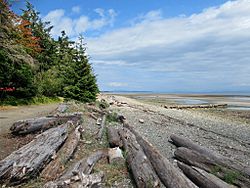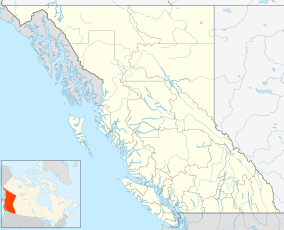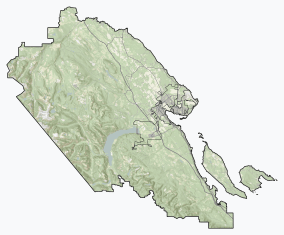Miracle Beach Provincial Park facts for kids
Quick facts for kids Miracle Beach Provincial Park |
|
|---|---|
|
IUCN Category II (National Park)
|
|

Miracle Beach
|
|
| Location | Vancouver Island, British Columbia, Canada |
| Nearest city | Campbell River, Courtenay |
| Area | 137 ha (340 acres) upland: 109 ha (270 acres) foreshore: 28 ha (69 acres) |
| Established | 1950 |
| Governing body | BC Parks |
Miracle Beach Provincial Park is a beautiful provincial park located on the eastern side of Vancouver Island in British Columbia, Canada. You can find it between the towns of Comox and Campbell River. The park has a lovely beach area along the Strait of Georgia. It also protects a big part of the Black Creek estuary, which is where the river meets the sea. Plus, there's a large forest area to explore.
Miracle Beach Park is mainly a place for fun activities. People love to play on the beach, have picnics, enjoy nature, and go camping here. It also helps protect the natural shoreline and the special estuary environment. The park has easy-to-access trails that lead to the beach. There's also a large camping area with 200 spots for vehicles. You can visit the nature centre to learn more about the park's wildlife. There's even a covered picnic area for groups. The trees you'll see are mostly Douglas-fir. Other common trees include Western hemlock, Sitka spruce, red alder, and bigleaf maple. You might also spot Salal and sword fern plants. Black Creek, which flows through the park, is an important place where coho salmon come to lay their eggs.
Contents
Park History: How Miracle Beach Began
People have lived in this area for a very long time. Coast Salish people used the land that is now Miracle Beach Park. Archaeologists have found old tools, like a hammerstone, within the park.
The land was first mapped out in the late 1800s for logging. Trees like hemlock and fir were cut down. More logging happened in the 1920s and 1930s. In 1948, a person named Frank Pottage bought the land. He wanted to build houses there. To get roads to the waterfront, he made a deal with the government. The province bought 57.5 hectares for a park. Six hectares at the mouth of Black Creek were given to the province. A public road was built to reach both the park and the new houses.
Miracle Beach Drive was built in 1952. The park was officially created in 1950. It started with 57 hectares. More land was added in 1951 and 1956, including the beach area. Later, a nearby landowner gave 3 more hectares of wetland to the park. This wetland helps the Black Creek estuary.
Why is it Called Miracle Beach?
There are a few interesting stories about how "Miracle Beach" got its name.
- One story says it's where a messenger from the Great Spirit appeared as a lost and hungry man. The We Wai Kai people helped him.
- Another story tells of the We Wai Kai seeing a woman turn to stone here, creating Mitlenatch Island.
- Some say it's called Miracle Beach because this area was saved from a big forest fire that burned everything around it.
- Others believe it's a miracle that some old, large trees survived here, even after fires and logging.
Fun Things to Do at Miracle Beach
Miracle Beach Provincial Park is a fantastic place for outdoor activities. You can enjoy the beach, go swimming, and simply appreciate nature. It's also perfect for scenic viewing, picnicking, and camping.
There are two main parking areas off Miracle Beach Drive. From these spots, you can easily walk or use a wheelchair to get to the beach. A network of trails runs along the beach and next to Black Creek. These trails also connect to the parking and camping areas.
At the south end of the beach, you'll find an outdoor picnic area. It has a change room, washrooms, and water taps. There's also a picnic shelter, which is great for groups or events. The Miracle Beach Nature House is a special nature centre. It was built in 1958 and has displays about local natural history. During certain seasons, they offer fun educational programs. Outside the Nature House, there's an amphitheatre with a screen for presentations.
Camping at Miracle Beach
About 30 hectares of the park are used for camping. There are 200 campsites where you can park your vehicle. The campground has showers, a sani-station for RVs, a playground, and many water taps and outhouses. The water is treated and safe to drink. The campground is open from April to October. You can also camp for a limited time in March. More and more people visit the park each year. In 1980, there were about 54,000 day visitors and 14,000 campers. By 2015, those numbers grew to 88,000 day visitors and 52,000 campers!
Nature and Wildlife at Miracle Beach
Miracle Beach Park covers 137 hectares. It has about 665 meters of shoreline along the Strait of Georgia. The beach itself stretches out a long way from the shore when the tide is low. This sandy beach area is called an intertidal zone. The ocean covers it twice a day when the tide comes in. The sand on Miracle Beach comes from other nearby beaches and rivers like Black Creek and Oyster River. The sand is slowly moving north towards Saratoga Beach.
The shoreline is made of small rocks and gravel, with lots of driftwood logs. Plants that grow well in the salty environment include gumweed, American dunegrass, and Vancouver wildrye. Many park visitors walk on the intertidal area. If you look closely, you might find animals like sand dollars, purple shore crabs, green shore crabs, and green burrowing anemones. In the fall, Coho Salmon swim from the sea up Black Creek to lay their eggs.
Forest Life and Trees
The land part of the park is in a special area called the Coastal Western Hemlock Biogeoclimatic Zone. This means that if the forest were left alone for a very long time, western hemlock would be the main tree. However, because the forest has been logged before, you'll mostly see Douglas-fir trees.
The air coming from the Pacific Ocean loses most of its moisture as it crosses the Vancouver Island Ranges. This means the park has warm, dry summers and wet winters. Other trees like Western redcedar and grand fir grow in drier, nutrient-rich spots. Red alder and bigleaf maple grow in sunny areas, like along the edges of clearings. In the older parts of the forest, you'll find plants that like shade. These include red huckleberry, salal, Oregon grape, sword fern, and vanilla-leaf.



